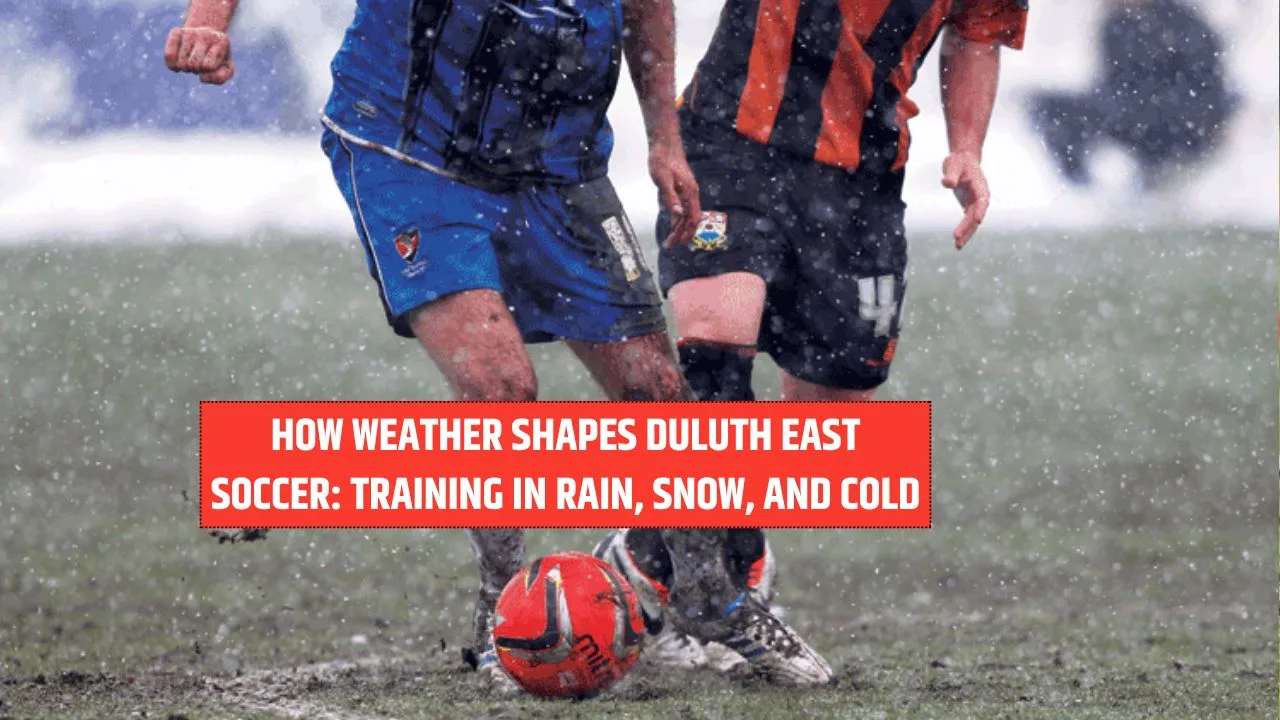Duluth East Soccer is not just a program, it’s a story of resilience and grit. Located in one of Minnesota’s coldest and most unpredictable regions, the team’s commitment to the sport is tested not only by their opponents but also by the wild elements of nature. From icy winds sweeping across fields to games played in relentless rain, their environment molds a different breed of athlete—one that doesn’t just play soccer, but endures it.
This article dives into the heart of how Duluth East Soccer thrives despite the challenges thrown at them by Mother Nature. We’ll explore how they train through the toughest months, what strategies they use to adapt, and why their conditions make them one of the most uniquely prepared high school teams in the country. From daily practice in snowy fields to maintaining peak performance during freezing games, you’ll get a full look at the culture of soccer in the far North.
Duluth East Soccer: Pushing Limits Through Weather
The heart of Duluth East Soccer lies in its ability to push forward in the face of discomfort. Unlike many other high school teams, these athletes are forged in some of the most extreme weather conditions in the United States. Snowfall doesn’t mean a day off, rain doesn’t cancel practice, and the biting cold becomes just another opponent to beat. This commitment to training through all conditions helps build stronger, smarter, and tougher players. Their preparation, which includes adapting to snow, rain, and freezing temperatures, makes them not only weather-resistant but mentally unbeatable. Whether it’s a cold-weather scrimmage or a rain-drenched match, these players show up ready to perform.
Overview: Weather Factors Shaping Duluth East Soccer
| Weather Type | Impact on Training | Adaptation Strategy |
| Rain | Slippery fields, reduced traction | Focus on ball control, shorter passes |
| Snow | Visibility issues, slowed pace | Indoor drills, snow-specific conditioning |
| Freezing Cold | Risk of injury, tight muscles | Extended warm-ups, thermal gear |
| Wind | Affects ball direction and flight | Low passes, more grounded play |
| Mixed Conditions | Unpredictable changes mid-session | Flexible practice plans, mental preparedness |
The Challenge of Duluth’s Climate
Duluth sits on the edge of Lake Superior, a spot known for its dramatic weather swings. This creates a unique obstacle for teams like Duluth East Soccer, who play through fall and early winter. Sudden storms, temperature drops, and high winds often appear mid-practice, making consistency difficult. But instead of retreating indoors every time the weather turns, the team has built a culture that sees these elements as part of the game. Coaches design drills with flexibility, ensuring players are always ready for the unexpected. While other teams might pause for safety or comfort, Duluth East keeps pushing—safely, but relentlessly.
Adapting to Training in the Rain
Training in the rain requires an entirely different mindset. It’s not just about staying dry; it’s about controlling a slippery ball on a soaked pitch. Duluth East Soccer players learn to use the wet field to their advantage, perfecting techniques that force them to think faster and move smarter. Slide tackles become more common, footing becomes unpredictable, and reaction time must be immediate. Coaches encourage players to adjust their cleats, maintain a lower center of gravity, and communicate constantly. Practicing in rain is no longer a disadvantage—it’s a skill set that makes these athletes dangerous on any field.
Embracing Snowy Conditions
Snow is part of life in Duluth for nearly half the year. For most teams, snow cancels practice. For Duluth East Soccer, it becomes part of the curriculum. Light snow is rarely a reason to skip the field. In fact, running in snow offers serious physical benefits—it strengthens the legs, enhances cardiovascular health, and improves coordination. Snow also forces a more strategic style of play. Players must learn how to pass more carefully, shoot more accurately, and anticipate movement with reduced visibility. When snow becomes too deep or dangerous, practices shift indoors where footwork and tactics are refined in tighter spaces.
Coping with Cold Temperatures
Cold weather might be the toughest opponent of all. Practicing in sub-zero conditions puts stress on both the body and the mind. To stay safe and effective, Duluth East Soccer emphasizes preparation. Players wear moisture-wicking layers, cover exposed skin, and arrive early for extended warm-ups. Practices are designed to keep players moving constantly to avoid cooling down. Water breaks are more frequent to counteract dehydration from cold air. The cold teaches discipline—players must focus, communicate, and stay sharp despite the chill that numbs their fingers and toes. This creates athletes who don’t fold under pressure, no matter the temperature.
Unique Benefits of Training in Harsh Weather
- Mental Endurance: Pushing through tough weather builds psychological strength and resilience.
- Enhanced Conditioning: Snow and cold act as natural resistance, increasing strength and stamina.
- Adaptability Under Pressure: Being prepared for any condition allows players to perform in a wide range of environments.
- Greater Focus and Unity: Shared struggle through difficult sessions builds stronger team bonds and trust.
Equipment and Preparation Tips
- Layer Up Wisely: Avoid cotton; choose synthetic layers that stay warm even when wet.
- Use the Right Footwear: Cleats with longer studs help grip in muddy or snowy conditions.
- Keep Spare Gear Ready: Players carry extra gloves, socks, and hats to change mid-practice if needed.
- Watch the Weather Closely: Coaches use real-time updates to adjust practices quickly and safely.
- Indoor Contingency Plans: Gyms, turf fields, or classroom sessions ensure training continues no matter what.
How Coaches Make a Difference
Behind every snow-covered drill or rain-soaked scrimmage is a coaching staff that knows how to manage adversity. The coaches of Duluth East Soccer prepare year-round, building flexible training plans and focusing on the whole athlete—not just technical skill, but mental toughness too. They teach players to read conditions, adjust game plans, and stay smart. Their leadership ensures safety while still maintaining high expectations. By modeling resilience and strategic thinking, they inspire players to do more than survive their training—they grow from it.
Community and Team Spirit
It’s not just the players who adapt—the entire Duluth East community supports this culture. Parents stand in the cold cheering from the sidelines, teammates push each other through hard drills, and alumni often reflect on the pride they felt earning wins in freezing temps. There’s a bond formed in weathered jerseys and snowy cleats that’s hard to replicate. This connection extends beyond soccer into life. These young athletes learn how to stay committed, push past excuses, and support each other through storms—literally and figuratively.
FAQs
1. What happens if the snow is too heavy to practice outside?
If conditions are unsafe, practice moves indoors where drills are adapted for space while still maintaining intensity.
2. How do players avoid injuries during cold weather soccer training?
Warm-ups are extended, gear is carefully selected, and coaches monitor players closely to reduce risks like pulled muscles or frostbite.
3. Is playing in the rain safe for high school athletes?
Yes, as long as lightning isn’t present. It offers valuable practice in ball control and body balance under tough conditions.
4. Do extreme weather practices give Duluth East a real advantage?
Absolutely. They’re more conditioned for unpredictable games and mentally stronger than teams used to perfect weather.
5. How does weather impact game strategy?
Game plans shift depending on field conditions—slower pace, tighter passing, and more focus on ground control are common in bad weather.
Final Thought
The story of Duluth East Soccer is more than just one of athletic success. It’s a blueprint for how adversity can become your greatest asset. In every flake of snow, gust of wind, or drop of rain, these players see opportunity. Their commitment to training in all weather conditions creates not only better athletes, but stronger, more resilient young people. Whether you’re part of a team or just a fan, there’s inspiration in their drive. If you’ve ever trained in tough conditions, tell us your story or share this with someone who knows the power of playing through the storm.











